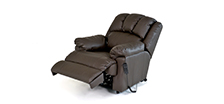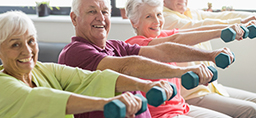
The idea of slowing down as you age may seem natural enough.
But it’s one of the last things you should do.
Experts have long known that more activity promotes better health as people age, but researchers in one study aimed to understand why.
They found that humans are uniquely designed to benefit from more activity as they age.
In many species, animals die soon after their ability to reproduce ends. Why do humans survive for decades after their period of peak reproductive usefulness ends?
In comparing early hunter-gatherer societies to apes, the researchers found that apes tend to be relatively inactive, and they typically live to about age 35 to 40 in the wild.
Early hunter-gatherers, by contrast, often lived seven decades—about 20 years past typical child-bearing age. These humans, who lived about 40,000 years ago, spent about 135 minutes per day in moderate to vigorous physical activity.
That’s roughly six to 10 times more activity than today’s typical American.
The findings support the idea that humans evolved to need more physical activity as they age.
Exercise is stressful and it has effects on your body at the molecular, cellular and tissue levels. It’s essential for your body to build back stronger, enabling you to live longer.
This strength-building process also likely guards against chronic illnesses that kill most Americans, such as cardiovascular disease, Type 2 diabetes and perhaps even some types of cancer.
“That perspective is fascinating,” said Phillip Adler, PhD, a licensed athletic trainer and operations manager for Spectrum Health Orthopedic Outreach. “But it’s also scary, since so many things in our culture and society push people into less activity as we age, instead of more.”
Dr. Adler said he’s inspired by the researchers’ stark distinction between lifespan, which measures how long we live, versus health span, which assesses the quality of our lives.
Aging well calls for a concerted effort to get more active, whether you’re completely sedentary or already fit, Dr. Adler said.
His advice? Start small, because big numbers—135 minutes of daily activity, or 10,000 steps a day—can sometimes be intimidating.
“Activity doesn’t have to be hard and it doesn’t have to go on for hours,” he said.
Some tricks he uses to help people get up and moving:
Stay active indoors
Bad weather—or just the prospect of lacing up the walking shoes—sometimes keeps many people housebound. Dr. Adler and his family members sometimes choose to walk inside.
“If you’re watching TV, stand up during commercials and walk around even for a minute or two inside the house,” he said.
Get high-tech
Technology can help motivate you and keep you accountable, and there’s no shortage of options these days.
You don’t need an expensive smartwatch, Dr. Adler said. Most smartphones are equipped with accurate step counters. Spend some time searching your phone settings, exploring Apple Health or Google Fit.
Dr. Adler is a fan of affordable fitness watches—both he and his wife wear Amazfit watches, which cost about $40.
Other budget brands that earn positive reviews from the tech community are the Xiaomi Mi Band series, the Huawei Band Pro series and lower-end offerings from Fitbit and Garmin.
It’s easy to set alerts to remind you to get up and moving when you’ve been sitting too long.
Stay social
Combine the feel-good benefits of seeing friends or family with an activity. Make plans to walk, either outdoors—bonus points for vitamin D—or indoors, such as a community center or mall.
Eat healthy
It’s important to remember that while physical activity is key to healthy aging, it’s easy to overlook the all-important connection to nutrition and sleep, Dr. Adler said.
Eating better doesn’t just lead to a healthier weight. It intensifies the connection between diet and exercise.
Keeping track of your daily calories is a good first step.
“Calories in, calories out may be a simplistic approach to health,” Dr. Adler said. “But it is helpful for people to begin to understand the relationship between physical activity and what they eat.”
When you learn that briskly walking for 55 minutes can burn 150 calories, for example, you’re more likely to choose a lighter lunch over a fast-food fat bomb.
Sleep well
These same principles apply to sleep. Getting adequate rest can help the body heal from the stress of activity.
It also creates a virtuous cycle: The more activity you get, the better your sleep. Better rest also leads to increased energy levels, which means you’ll feel more receptive to activity later.
Keep in mind that those who skimp on sleep are at a higher risk of chronic illness, including heart disease, diabetes and depressed immune functions.
For optimal aging—which means a healthier life span, not just a longer one—it all comes down to what Dr. Adler calls The Big Three: “Healthy aging comes down to managing activity, nutrition and sleep as well as we can.”
 /a>
/a>
 /a>
/a>
 /a>
/a>